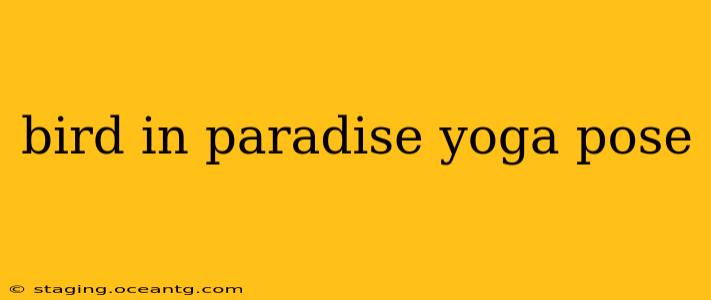The Bird of Paradise pose, or Natarajasana, is a beautiful and challenging yoga asana that requires strength, balance, and flexibility. This advanced standing pose is a stunning display of grace and power, but it's crucial to approach it with care and respect for your body's limitations. This guide will explore the pose in detail, addressing common questions and providing a safe and effective approach to mastering this exquisite asana.
What are the benefits of Bird of Paradise pose?
The Bird of Paradise pose offers numerous physical and mental benefits. Physically, it strengthens the legs, ankles, and core muscles. It improves balance and coordination, and increases flexibility in the hips, groin, shoulders, and spine. Mentally, this pose fosters focus and concentration, helping to quiet the mind and promote a sense of calm amidst the challenge. The deep stretch also helps release tension in the hips and back, contributing to overall relaxation.
How to do Bird of Paradise Pose (step-by-step instructions)?
While a full Bird of Paradise pose requires significant flexibility and strength, we can break it down into achievable steps. Beginners should focus on building foundational strength and flexibility before attempting the full pose:
-
Standing Tadasana (Mountain Pose): Begin by standing tall with your feet together, grounding down through your feet. Find your center.
-
High Lunge: Step your right foot back into a high lunge, aligning your right knee over your right ankle.
-
Bending the Knee: Bend your left knee deeply.
-
Grasping the Foot: Reach back and grab your right foot with your right hand. You might need a strap initially for assistance.
-
Lifting the Leg: Gently lift your right leg, aiming to bring your heel towards your buttock.
-
Balancing and Opening: Now, this is where the challenge begins. With control and focus, reach your left hand up towards the sky. Slowly begin to extend your right leg further back, and try to straighten it. Balance will be crucial here.
-
Chest Expansion: Keeping your torso upright, breathe deeply and broaden your chest.
-
Gaze: Soften your gaze and fix it on a single point to maintain balance.
Important Note: Do not force the pose. Listen to your body and stop if you feel any pain. Use props like blocks and straps to assist you until you develop the necessary flexibility and strength.
How long should I hold the Bird of Paradise pose?
Hold the Bird of Paradise pose for as long as you feel comfortable and balanced. Begin with just a few breaths, and gradually increase the duration as your strength and flexibility improve. Aim for 30 seconds to a minute on each side as you progress. Quality over quantity is always preferred in yoga.
Is Bird of Paradise pose safe for beginners?
The full expression of Bird of Paradise pose is indeed challenging and not recommended for absolute beginners. However, the preparatory steps and modifications can be beneficial even for those new to yoga. It's essential to build a strong foundation of balance and flexibility before attempting the full pose. Working with a qualified yoga instructor can provide guidance and ensure safe practice.
What are some modifications for Bird of Paradise pose?
Several modifications can make the Bird of Paradise pose more accessible:
- Use a strap: A strap can help you reach your foot if you lack the flexibility in your hamstrings and shoulders.
- Bend your standing knee less: If your balance is compromised, keep your standing knee slightly bent for extra stability.
- Place your foot on a block: Placing your lifted foot on a block can make the pose less demanding.
- Practice near a wall: Using a wall for support can aid in balance.
What are some common mistakes to avoid in Bird of Paradise Pose?
- Forcing the pose: Avoid forcing the pose beyond your current capabilities. This can lead to injury.
- Rounding your spine: Maintain a long and extended spine throughout the pose.
- Looking down: Keep your gaze fixed on a spot to help maintain balance.
- Ignoring your breath: Deep, conscious breaths are crucial for stability and relaxation.
By following these guidelines and focusing on proper alignment and mindful breathing, you can safely and effectively progress towards mastering the stunning Bird of Paradise pose. Remember, consistency and patience are key to achieving progress in any yoga asana. Always listen to your body and consult a qualified yoga instructor for personalized guidance.
